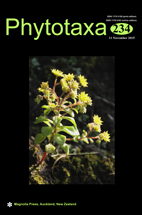Abstract
The genus Glyptopetalum Thwaites (1856: 267) consists of approximately twenty species distributed in tropical and subtropical Asia (Liu & Funston 2008). It belongs to the family Celastraceae and is very close to the genus Euonymus Linnaeus (1753: 197). Hou (1962, 1963) provided the best overview of Glyptopetalum, describing plants of that genus as shrubs or small trees with 4-merous flowers, 4-locular ovaries, pendulous ovules, with one per locule, loculicidal capsules with persistent columella and branched raphes. In particular, he stressed that one ovule per cell, persistent columella and branched raphes are the most reliable characteristics for distinguishing Glyptopetalum from Euonymus. Simmons et al. (2012) consider both Glyptopetalum and Torralbasia as closely related to Euonymus based on their experimental data of two (of 20) species of Glyptopetalum. However, they recommend that Glyptopetalum continues to be recognized as distinct from Euonymus, based on the three reproductive differences noted by Hou (1963). Li et al. (2014) also support this view based on their molecular data. Consequently, we recommend that Glyptopetalum be recognized as a distinct genus in this paper.

